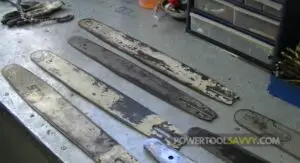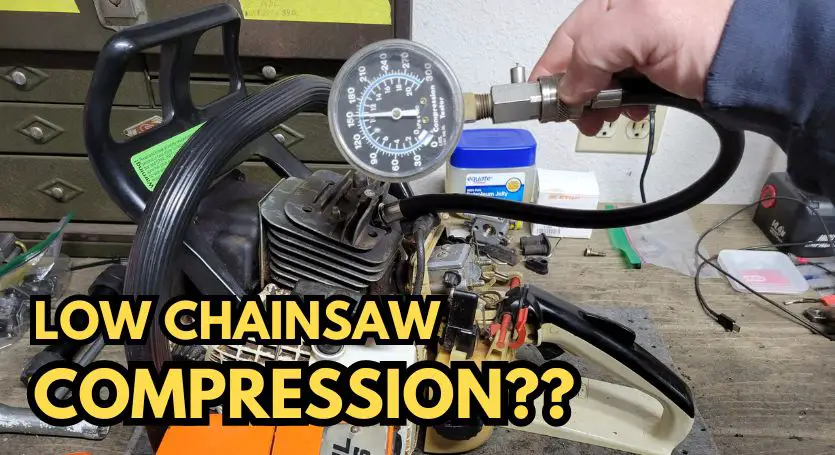
Are you in the middle of troubleshooting your saw’s engine?
Here’s a quick answer to the question: 👇
The ideal engine compression for any chainsaw is between 120-160 psi. If your saw’s compression is below 110 psi, it’s considered “low” and may need some attention. Likewise, anything above 160 psi is considered “high” and can lead to issues like knocking & pre-ignition.
Btw, I’m Sam & I have over two decades of experience working with chainsaws. I’ve seen my fair share of compression-related issues & I’m here to help!
In this article, I’ll be discussing-
- ✅ what low compression is,
- ✅ causes & symptoms of low compression,
- ✅ how to test your saw’s engine compression & a whole lot more!
So, without further ado, let’s dive in!
Table of Contents
ToggleWhat is Chainsaw Engine Compression?
Almost all modern chainsaws have a two-stroke engine.
As the name suggests, a two-stroke engine requires only two piston movements (strokes) to complete one full combustion cycle.
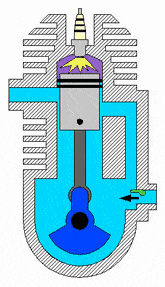
- Compression Stroke: The air-fuel mixture enters the chamber, and the piston goes up, squishing this mixture.
- Combustion Stroke: The spark plug ignites the mixture, creating a big explosion that pushes the piston down and makes the engine go vroom!
Long story short, the chainsaw engine works by creating a mixture of fuel & air, compressing it, and then igniting it to generate power.
And by engine compression (psi), we mean the pressure created in the compression stroke.
Why is Engine Compression So Important?
Well, without the correct compression (psi), the engine would not be able to run efficiently!
Low compression??
The air-fuel mixture would not be compressed enough to create a powerful explosion, resulting in –
- low power,
- poor fuel efficiency,
- and even damage to the engine.
High compression??
The air-fuel mixture would be compressed too much, causing pre-ignition and knocking. This not only affects the saw’s performance but can also destroy the engine.
But most of the time, a chainsaw engine suffers from low compression rather than high!
Will a Chainsaw Start with Low Compression?
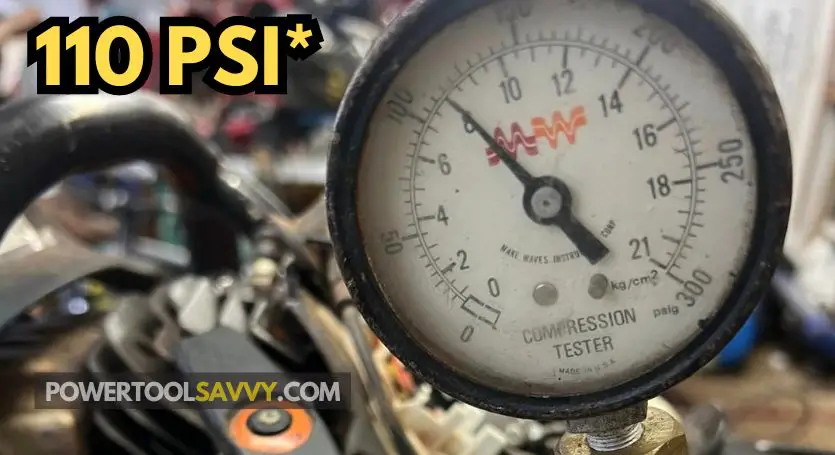
Normally, a chainsaw with engine compression below 110 psi won’t start. Even if it does, it won’t stay running for long, and you’ll notice a significant loss of power.
“But Sam, my saw is below 100 psi, but it’s still working fine!“
Well, most probably, you’re testing it with a faulty compression gauge!
I’ve seen it happen many times. So, always double-check with a different gauge before jumping to conclusions!
(By the end of this article, I’ll show you how to test your saw’s compression the right way! You won’t want to miss this!)
What Causes Low Compression in a Chainsaw?
To be frank, there are tons of things that can cause low engine compression in a chainsaw.
But here are the TOP 6 reasons: 👇
- Worn piston rings: As the engine runs, the piston rings wear down & lose their ability to seal off the combustion chamber. This leads to a loss of compression. (A common culprit!)
- Cylinder wall damage: Just like piston rings, the cylinder walls can also wear out over time, reducing compression.
- Leaky head gasket: A damaged head gasket won’t be able to seal the combustion chamber completely, causing a loss of compression!
- Worn or damaged valves: If the engine’s intake or exhaust valves are worn, they won’t seal properly, leading to compression loss.
- Wrong valve timing: Incorrect valve timing often results in low compression (as the valves may not be opening and closing at the right time!).
- Carbon Deposits: Excessive carbon buildup on the piston crown, valves, or cylinder head can cause low compression.
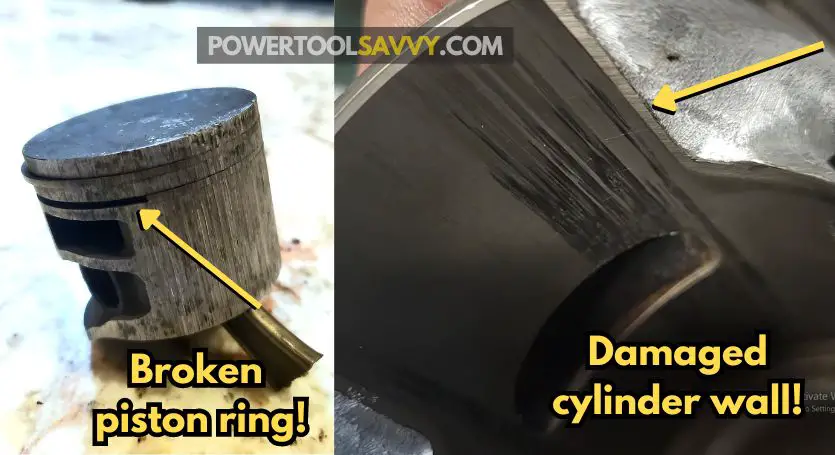
That’s why I make it a habit to inspect (and possibly replace) the piston rings and the head gasket when the compression starts to dip.
Plus, I get the cylinder checked periodically! 😎
Symptoms of Low Compression in a Chainsaw
Here are 4 symptoms that your chainsaw’s compression is low: 👇
Struggles to Start
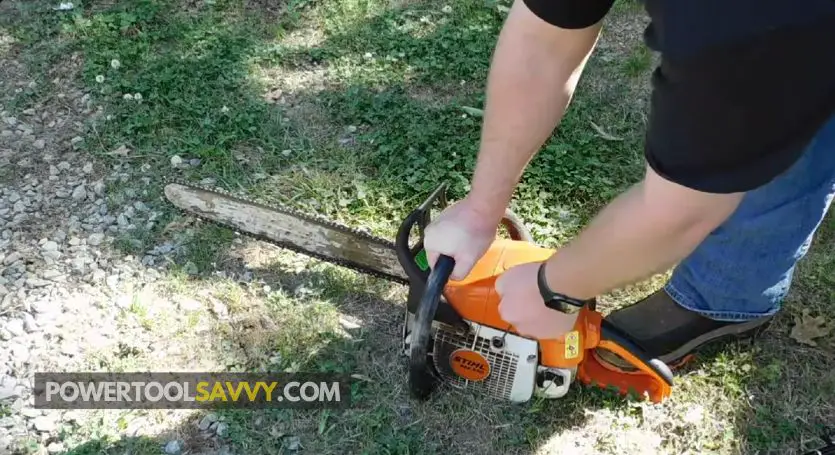
If your “trusty” chainsaw won’t start, low compression is likely the culprit!
With low compression, there’s not enough pressure to ignite the air-fuel mixture, making it difficult for the engine to start.
You might have to pull the starter cord hundreds of times before the engine finally catches on.
Loss of Power
Even if you manage to start your saw, you’ll notice a significant loss of power!
Low compression means less powerful explosions in the combustion chamber. Which in turn results in reduced power output from the engine.
A few days back, my old Stihl MS170 became harder to start. When it finally did, it lacked its usual charm!
After a bit of troubleshooting, I found out that the piston rings were worn out. A quick replacement solved the issue for me!
Stalling
If your chainsaw engine lacks compression, it won’t stay running for long. You’ll notice frequent “stalling” (especially under load!).
That’s because the air & fuel mixture won’t ignite properly. As a result, the engine will struggle to stay running and may conk out mid-cut.
Poor Fuel Efficiency
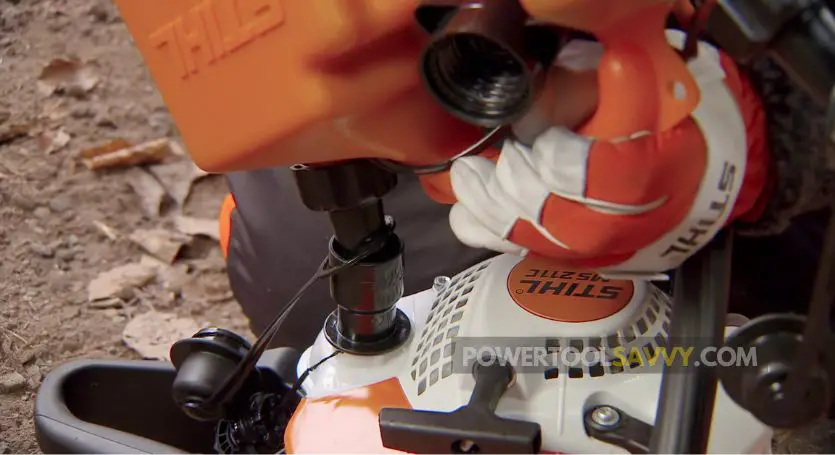
Low compression can also hurt your saw’s fuel efficiency. With less pressure in the combustion chamber, not all of the fuel is burnt.
Instead, some of it escapes along with the exhaust gases, wasting precious fuel and money.
So, you may find yourself visiting the gas station more often! ⛽
How to Test Chainsaw Engine Compression?
Does your chainsaw have low compression?
Well, the only way to know for sure is by testing it!
You’ll need a specialized tool known as a “compression tester.” You can find one for under $20 on Amazon. (Make sure it says “for small engines“)
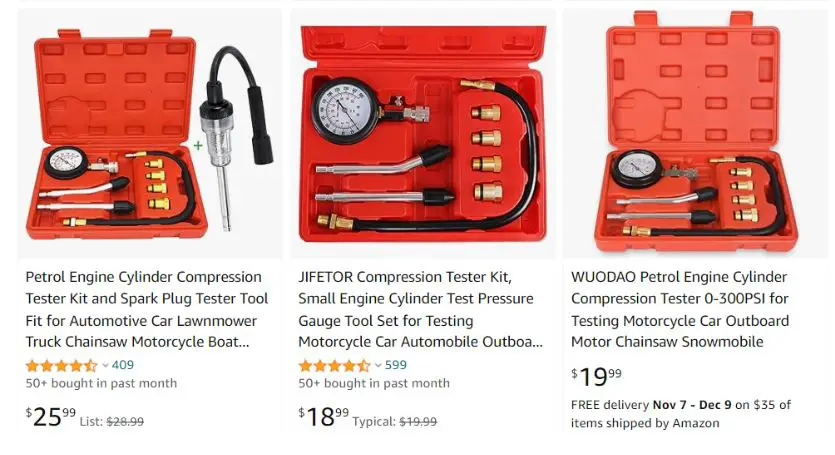
Here’s a step-by-step guide to test your saw’s compression: 👇
- Remove the back cover of your saw & take off the spark using the scrench.
- Attach the compression adapter to the spark plug hole. (Don’t over-tighten & make sure the gauge is zeroed!)
- Hold the throttle wide open. (You can use zip ties to lock the throttle in place!)
- Now, pull the starter cord as many times as it takes for the needle on the gauge to stop moving. (Usually around 5-6 pulls)
- Once the needle stops moving, note down the PSI reading on the gauge.
✍️ Note: Always do your compression test when the engine is “cold” for accurate results! And again, hold the throttle wide open so air can easily enter the engine!
Here’s a also a detailed video tutorial: 👇

